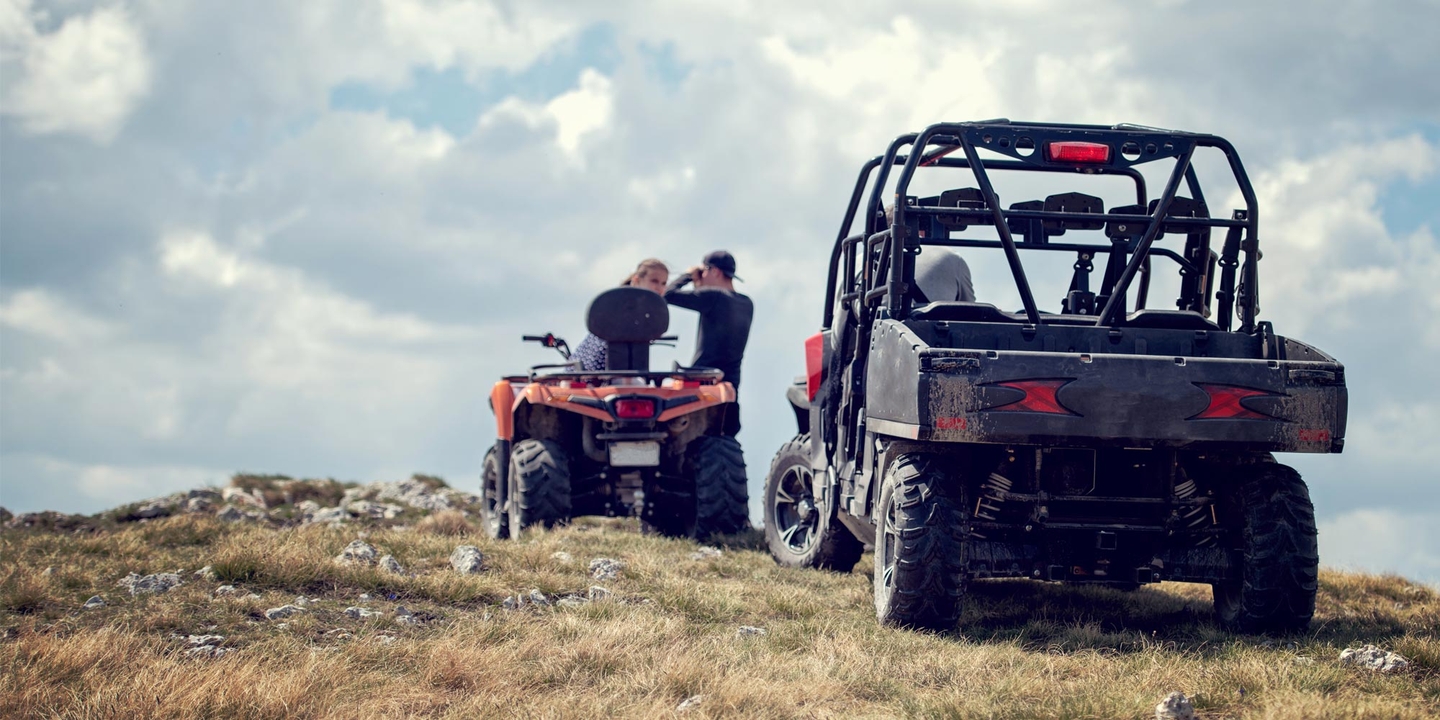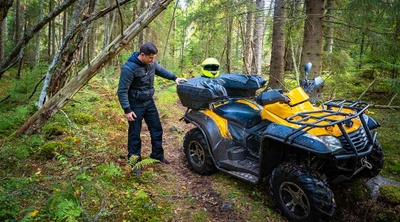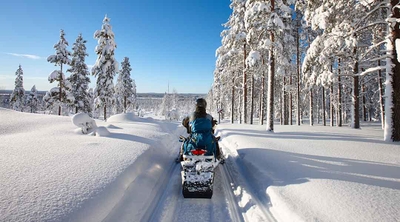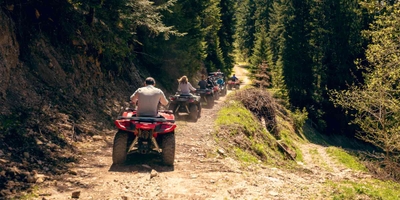ATVs and UTVs: Everything you need to know
7 min read
Whether you prefer solo off-road riding with quick turns or need a utility vehicle for specialized work, both all-terrain vehicles (ATVs) and utility terrain vehicles (UTVs) are great off-road vehicles for getting around outdoors and for fun. One of the most commonly asked questions is “What’s the difference between an ATV and a UTV?”
We’re breaking down everything you need to know about ATVs and UTVs so you know what you’re getting in your new off-road toy. Let’s start with everything you need to know about ATVs and then we’ll cover UTVs.
What is an ATV?
ATVs offer an efficient way to get around outdoors. They’re especially great for single roads, off-road trails, and making quick turns.
ATVs are typically equipped with a straddle seating position (think riding a bicycle with one leg on either side of the seat), handlebar steering (like a bicycle or motorcycle, not a wheel like a car or truck), and the ability to maneuver through a variety of terrain and conditions. While there are an array of ATV customizations and modifications available, at their base, all ATVs share those same three features: seating position, handlebar position, and all-terrain use (except water!).
ATVs are commonly used for practical transportation and recreation, like racing or trail riding.
Cost of ATVs
Compared to UTVs, ATVs are the much more budget-friendly option. The cost of new ATVs ranges from a few thousand dollars to more than $15,000. For some customers, used ATVs might be more affordable. Used ATVs start as low as a few hundred dollars, but most well-maintained ATVs will still run you over a couple thousand dollars. When planning a purchase, don’t forget additional costs like safety gear and insurance!
Youth ATVs for kids
Youth ATVs are for those little riders that have little to no riding experience. They are smaller than other types of ATVs and usually come in engine sizes between 50 cc and 110 cc (in some cases 125 cc). Youth ATVs offer little or no suspension, low power, and either an automatic transmission or no gears at all. All these features make it safer and more intuitive for younger riders to learn and use an ATV.
There are multiple manufacturers who make dozens of different four-wheelers that are specially designed for kids and loaded with safety features like engine limiters and more. Check out the 5 Best ATVs to Buy for Your Kids.
What is a UTV?
UTVs, often called side-by-sides (SXS), are built and used more for specialized work than for recreation. UTVs are large and powerful vehicles that are able to seat passengers side by side, and they’re typically built with lots of storage space. UTVs are commonly used to haul equipment and supplies in places that may otherwise make using a truck impractical or impossible.
UTVs have a lot of storage space and are very popular vehicles for farming, as they have the ability to haul feed, hay, and supplies. However, UTVs are also becoming more popular in non-agricultural communities like schools for hauling items like sports equipment. Interested in just having a larger vehicle for off-roading fun? There are also sport UTVs so you can rip around the trails with friends!
Cost of UTVs
One of the awesome things about UTVs is that they’re customizable and versatile, but that comes at a price. New side-by-sides start at about $5,000, and can run as high as $30,000. Used UTVs can be as low as a couple thousand dollars, but again be careful about what you purchase at that price. You can’t forget additional costs like safety gear, insurance, and any other “extras” you might want!
Best UTVs for working and farming
The best UTVs for working and farming will typically have features like storage and cargo capacity, a reliable engine, and the ability to tow. When you’re looking for a UTV for working or farming, make sure it has all the features you need to get the job done (i.e. space, capacity, performance, and more).
Some of the best and most popular UTVs that are loaded with special features for working and farming are the Kawasaki Mule Pro-FXT, the Honda Pioneer 1000, the Yamaha Viking EPS, and the Can-Am Defender.
Types of ATVs and UTVs
Although ATVs are for riding trails and racing and UTVs are typically used for work, there are different types of ATVs and UTVs that are designed and manufactured for different uses, which include: racing, hunting, farming, recreation, military, emergency services, and more. As you can see, there’s an off-road ATV/UTV for just about anything.
The different types of ATVs range in size from 50 cc youth ATVs up to 700 cc sports ATVs, 800 cc utility ATVs, and even side-by-sides and UTVs over 1,000 cc.
Sports ATVs
Sports ATVs are lightweight quads that range in size from 250cc on up to 700cc. They have a ton of suspension to handle jumps, bumps, and turns. Sports ATVs can be modified and enhanced with thousands of ATV accessories that can not only change the style of the quad, but also its performance.
Utility ATVs
Utility ATVs are much heavier, have less suspension travel, a big motor, and more accessories designed for specialized work, farming or hunting. While they’re manufactured more for work-related purposes, utility ATVs also enjoy their recreation time in OHV areas.
Brands of ATVs and UTVs
Now that you know about the types of ATVs and UTVs, let’s talk about brands. ATV and UTV manufacturers do their best to make great vehicles for both on and off-road use. We’ve rounded up a short list of some of the most popular ATV and UTV brands.
- Polaris: Polaris manufactures some of the top UTVs in the world. Featuring trail-ready power and performance and more chiseled looks, Polaris’ off-road vehicles are loaded with the styles and features you’ve been wanting. Popular Polaris ATVs include the Sportsman and the Scrambler, while the Ranger, the RZR, and the General are great UTVs.
- Can-Am: Can-Am offers the perfect combination of industry-leading performance, precision-engineered handling, and rider-focused design. Popular Can-Am ATVs are the Outlander and the Renegade, and popular UTVs are the Maverick and the Commander.
- Yamaha: Realize your adventure with Yamaha! Manufacturing a wide range of durable and reliable all-terrain and utility vehicles for trail riding, racing, working, farming, hunting and more. Popular ATVs are the Kodiak and the Grizzly. Popular side-by-sides manufactured by Yamaha include the Viking and the Wolverine.
- Honda: Honda manufactures ATVs and UTVs that are built for work and for fun. Popular ATVs include the FourTrax Rancher and the TRX. Popular UTVs include the Pioneer and the Talon.
- Kawasaki: Kawasaki manufactures powerful user-friendly ATVs and UTVs that are loaded with features to increase recreational capabilities and more. Popular ATVs are the Brute Force and the KFX. Popular side-by-sides are the Mule and the Teryx.
- Suzuki: Suzuki introduced the industry’s first four-wheeled ATV in 1983. Now, they’re releasing fully redesigned models that are loaded with features and ready for work and play. Popular Suzuki ATVs are the KingQuad and the QuadSport.
- Textron: Textron is known for making side-by-sides and ATVs built on power and performance, and with the acquisition of Arctic Cat in 2017, they have a great lineup of vehicles. Popular ATVs are the Alterra and the Mudpro, and popular UTVs are the Wildcat and the Prowler.
There are so many more brands who manufacture ATVs and UTVs. Just make sure to do your research so you can find one that’s right for you!
ATVs and UTVs: Gear you’ll need
You can’t forget about safety and protection. There is some gear you’ll need to (and want to) consider before heading out to the trails.
- Protective clothing: It’s recommended that off-road riders wear protective clothing like long sleeves, long pants, and over-the-ankle boots while riding. Motocross gloves are also a must, as you don’t want a rock to the knuckle.
- Helmets: Accidents can and do happen. It’s important to have a high-quality ATV helmet in order to keep your head safe from injuries. Helmets should not only be comfortable and durable with the proper fit, but they should also be approved by the Department of Transportation (DOT), and in some cases, certified by SNELL.
- Goggles: Motocross goggles are very important to protect your eyes. There’s a lot of wind, rocks, dirt, dust, and branches that could affect or injure your eyes out on the trail.
- Toolkit: Everyone needs a simple toolkit to help them whenever they are in a bind. Toolkits should have a few basic items like a Swiss Army knife, wrenches, duct tape, a trail map, a tire pressure gauge, and a multifunctional screwdriver. Other items can include a vise grip, an air pump, tire plugs, and anything else to get you back on the trails.
- First-Aid kit: It doesn’t hurt to carry a small first-aid kit. Your first-aid kit should include things like band-aids, antibiotic ointment, gauze, and more to handle any scrapes and/or injuries until you can get to a doctor.
- Winch: It’s always a good idea to add a winch to your ATV. Winches help to exert a force that pulls one object toward another using a cable or rope. Winches are best used to get yourself out of sticky situations. For example, you can attach a winch to a tree and get yourself unstuck rather than calling a friend and waiting for them to come to help you.
ATVs and UTVs: What’s the difference?
As you can see, ATVs and UTVs have quite a few things in common—four-wheeled, off-road vehicles made by the same manufacturers. However, there are quite a few differences between the two.
- Size: ATVs are smaller than UTVs and are usually meant for single riders (sometimes two), while UTVs and side-by-sides can seat two to four people.
- Use: ATVs are great for racing and trail riding because they are smaller and easier to handle, while UTVs are great for hauling things and getting through rougher terrain.
- Seating: On ATVs, you straddle the seat (like a saddle) to ride, while UTVs have benches or bucket seats.
- Steering: ATV’s use handlebars to steer like traditional bikes, while UTV’s have a steering wheel like cars or trucks.
Now that you know everything about ATVs and UTVs, make sure to get an off-road vehicle that best suits your needs and lifestyle. That means, if you’re looking for something to help you haul stuff, make hunting easier, and work around the farm, you need a UTV. Likewise, if you’re more of a single trail rider who occasionally likes to race, an ATV would be perfect for you.
Just remember to do your research! If you’re looking to price and buy an ATV or UTV, make sure to check out the Progressive Outdoor Vehicle Buying Program for upfront pricing and special savings.






